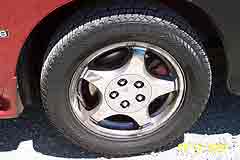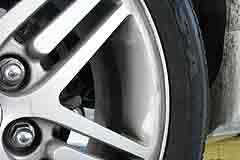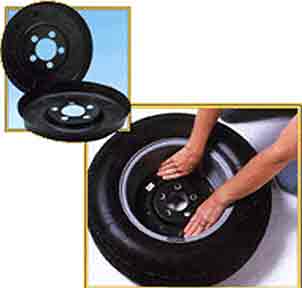I am fortunate to live in Southern California where maintaining a car looking great is a pretty easy task year around. A monthly wash and annual waxing keeps my Saab looking great, except for the alloy wheels. Within a few miles, the wheels are covered by a coating of black dust. Not only is the dust unsightly, it is quite corrosive. Left on the wheels for any lengthy period of time, the dust mixed with water becomes an acid that can etch the finish on the wheel.

As disk brakes do their job and brake pads act against brake rotors, friction creates the dust. The dust is composed of the materials used in the pads, and lesser extent the rotors. This includes carbon fibers, metallic particles and polymer adhesives used in manufacturing the brake pads. The latter is the main reason the dust sticks to the wheels and make cleaning difficult.
Dust prevention is trade off between appearance and performance. Hard pads don't produce as much dust, but often don't stop as well, have a greater tendency to squeal and are more likely to score rotors. Softer pads perform better, are quieter, but produce more dust. Great braking European cars like BMWs, Audis, Volvos and Saabs use quite soft pads and thus are very prone to be covered with black dust.
Because brake dust is corrosive, it should be cleaned off frequently. There are two basic types of wheel cleaners - acid-based and acid-free. Acid-based cleaners make short work out of cleaning wheels and require minimum effect, but typically they contain a small amount of oxylic, phosphoric and/or hydrochloric acid to accomplish this. If these cleaners are allowed to dry on wheel, they can etch the surface. You should not use these cleaners on wheels with pitted or chipped surfaces since the acid can get into the cracks to speed up flaking and peeling of surface coatings. Most spray-on/hose-off wheel cleaners are of the acid-based type, as are those used at car washes and by detailers.

The acid-free cleaners contain a mild solution of an alkaline solvent, usually ethylene glycol, and a wetting agent. These cleaners work by getting under the dirt and dust, loosening and lifting surface grime. These cleaners do require more work since a soft brush or sponge often has to be used with them. However, they are much safer to the wheels.
No matter the type of cleaner used, clean the wheels before washing the vehicle itself so you donÃt get cleaners as well as dirt and brake dust on already cleaned body parts. Do not clean hot wheels until they cool down and clean one wheel at a time. Do not let cleaner dry on a wheel, especially if you use an acid-based cleaner. Scrub with a soft brush or sponge to remove stubborn dust and dirt. After cleaning, apply an appropriate wax to painted and clear coated wheels not only for protection, but to make cleaning easier next time.

If you want reduce brake dust production substantially, switch to a harder pad, but make sure you donÃt compromise braking, especially if you own a high performance car like a BMW, Corvette or Porsche. Softer pads are used for a reason, better stopping power. There are some aftermarket pads that are more than adequate replacements. These include Kevlar and carbon- Kevlar pads as well as pads that contain more metal in lieu of carbon content. Of course, these will usually be more expensive than stock pads, but will probably last for more miles. Check with dealer, your mechanic or a brake specialist before switching.

Finally, you can install dust shields that fit between the brake caliper and the wheel. They are installed by removing the wheel, fitting the shield against the wheelÃs inside surface and replacing the wheel. The shields come in sizes to fit most vehicles with both OEM and aftermarket wheels. They do not hinder brake cooling.




